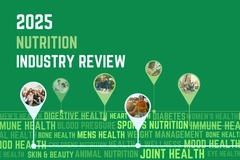Global EPA and DHA omega-3 supply chain is in recovery, says GOED analysis

Last year, the total global volume of eicosapentaenoic acid (EPA) and docosahexaenoic acid (DHA) omega-3 ingredients grew by 2.5% from 2023, according to new estimates from a detailed global supply chain review. At 131,183 metric tons, the overall value of these ingredients increased by 10.2% to US$2,379.7 million.
The report was recently published by the Global Organization for EPA and DHA Omega-3s (GOED), an umbrella group of the EPA and DHA omega-3 industry. It gathers data collected from 2023 and 2024 and forecasts through 2027.
The analysis covers all EPA and DHA sources in six finished product applications in 11 different geographic regions. It spans dietary supplements, pharmaceuticals, food and beverages, pet nutrition, infant formula, and clinical nutrition/medical foods.
The report also illustrates key developments that impacted market dynamics over the last year, which proved to be a recovery year after the supply chain challenges in 2023.
“2024 was a recovery year after one of the strongest El Niño events on record disrupted the supply chain for Peruvian anchovy oils, the main raw source, in 2022/2023,” reads the GOED report.
“The resulting supply shortages and high prices had a profound effect on the industry, and this only started resolving in the second half of the year.”
Supplements and pet nutrition drive growth
GOED highlights that pet nutrition and dietary supplements are still primary drivers of growth for EPA and DHA omega-3s, alongside commercial activities in emerging geographic markets.
 Following one of the strongest El Niño events on record disrupted the supply chain for Peruvian anchovy oils in 2022-2023, 2024 was a year of recovery for omega-3.The report also zeroes in on critical factors expected to influence future category growth, such as tariffs, fishery developments, pricing dynamics, regulatory requirements, pharmaceutical approvals, and new scientific findings.
Following one of the strongest El Niño events on record disrupted the supply chain for Peruvian anchovy oils in 2022-2023, 2024 was a year of recovery for omega-3.The report also zeroes in on critical factors expected to influence future category growth, such as tariffs, fishery developments, pricing dynamics, regulatory requirements, pharmaceutical approvals, and new scientific findings.
GOED’s report is based on proprietary sales data from more than 200 of its member companies. These represent the entire supply chain of EPA and DHA omega-3s, from fisheries and crude oil suppliers to refiners, concentrators, and finished product brands.
The organization considers its latest report to be the “most accurate and comprehensive” report available on the global EPA and DHA industry.
A sample of the report, as well as purchase information, is available on the GOED website.
Sector activities
Despite these positive developments, research earlier this year from Case Western Reserve University, US, warned of a global shortage of omega-3, driven largely by environmental factors such as rising ocean temperatures, overfishing, and pollution. The researchers also note that 85% of the world’s population do not get enough omega-3s in their diets.
With the sustainability of global fisheries being a critical consideration for marine omega-3 suppliers, alternatives to fish and krill oil continue to gain traction. Corbion recently secured multiple regulatory approvals from China, opening pathways for commercializing its algae-derived omega-3 DHA solutions in the country’s fast-growing human and animal nutrition sectors.
Nutrition Insight recently dove into the newest product innovations around omega-3s with insights from dsm-firmenich, Gelita, GC Rieber VivoMega, Epax, and Aker BioMarine.
Last month, we met Sara Lesina, general manager at Sirio Pharma Europe, to talk about new delivery technologies and consumer expectations that are reshaping the omega-3 market, urging brands to go beyond “science-backed” claims.












